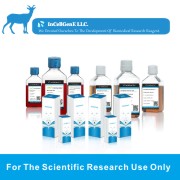

Overview
| Organism | Homo sapiens, human |
|---|---|
| Tissue | Liver |
| Product Format | frozen |
| Morphology | epithelial |
| Culture Properties | adherent |
| Biosafety Level |
2 [Cells contain Hepatitis B]
Biosafety classification is based on U.S. Public Health Service Guidelines, it is the responsibility of the customer to ensure that their facilities comply with biosafety regulations for their own country. |
| Disease | hepatocellular carcinoma |
| Age | 8 years juvenile |
| Gender | male |
| Ethnicity | Black |
| Applications |
This cell line is a suitable transfection host.
|
| Storage Conditions | liquid nitrogen vapor phase |
| Disclosure | This material is cited in a US or other Patent and may not be used to infringe the claims. Depending on the wishes of the Depositor, ATCC may be required to inform the Patent Depositor of the party to which the material was furnished. This material may not have been produced or characterized by ATCC. |
Properties
| Karyotype | modal number = 60 with a subtetraploid mode of 82; has a rearranged chromosome 1 (Knowles BB, Aden DP. Human hepatoma derived cell line, process for preparation thereof, and uses therefor. US Patent 4,393,133 dated Jul 12 1983) |
|---|---|
| Clinical Data |
8 years juvenile
Black
male
|
| Genes Expressed |
alpha fetoprotein (alpha-fetoprotein); hepatitis B surface antigen (HBsAg); albumin; alpha2 macroglobulin (alpha-2-macroglobulin); alpha1 antitrypsin (alpha-1-antitrypsin); transferrin;,alpha1 antichymotrypsin (alpha-1-antichymotrypsin); haptoglobin; ceruloplasmin; plasminogen; complement (C3, C4); C3 activator; fibrinogen; alpha1 acid glycoprotein (alpha-1 acid glycoprotein);,alpha2 HS glycoprotein (alpha-2-HS-glycoprotein); beta lipoprotein (beta-lipoprotein); retinol binding protein (retinol-
|
| Cellular Products |
Cellular products: alpha fetoprotein (alpha-fetoprotein); hepatitis B surface antigen (HBsAg); albumin; alpha2 macroglobulin (alpha-2-macroglobulin); alpha1 antitrypsin (alpha-1-antitrypsin); transferrin;
(Knowles BB, Aden DP. Human hepatoma derived cell line, process for preparation thereof, and uses therefor. US Patent 4,393,133 dated Jul 12 1983)
alpha1 antichymotrypsin (alpha-1-antichymotrypsin); haptoglobin; ceruloplasmin; plasminogen; complement (C3, C4); C3 activator; fibrinogen; alpha1 acid glycoprotein (alpha-1 acid glycoprotein);
(Knowles BB, Aden DP. Human hepatoma derived cell line, process for preparation thereof, and uses therefor. US Patent 4,393,133 dated Jul 12 1983)
alpha2 HS glycoprotein (alpha-2-HS-glycoprotein); beta lipoprotein (beta-lipoprotein); retinol binding protein (retinol-binding protein); Gc globulin
(Knowles BB, Aden DP. Human hepatoma derived cell line, process for preparation thereof, and uses therefor. US Patent 4,393,133 dated Jul 12 1983)
|
| Tumorigenic | Yes |
| Effects |
Yes, forms tumors in nude mice
|
| Comments |
This line contains an integrated hepatitis B virus genome.
|
Background
| Complete Growth Medium |
The base medium for this cell line is ATCC-formulated Eagle''s Minimum Essential Medium, Catalog No. 30-2003. To make the complete growth medium, add the following components to the base medium: fetal bovine serum to a final concentration of 10%. |
|---|---|
| Subculturing |
Remove medium, and rinse with 0.25% trypsin, 0.53 mM EDTA solution. Remove the solution and add an additional 1 to 2 mL of trypsin-EDTA solution. Allow the flask to sit at room temperature (or at 37��C) until the cells detach. Add fresh culture medium, aspirate and dispense into new culture flasks. Corning® T-75 flasks (catalog #430641) are recommended for subculturing this product.
Subcultivation Ratio: A subcultivation ratio of 1:4 to 1:6 is recommended
Medium Renewal: Twice per week
|
| Cryopreservation |
Freeze medium: Complete growth medium, 95%; DMSO, 5%
Storage temperature: liquid nitrogen vapor phase
|
| Culture Conditions |
Temperature: 37��C
Atmosphere: air, 95%; carbon dioxide (CO2), 5% |


